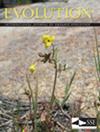树木中体细胞突变率和表观突变率的异速缩放。
IF 3.1
2区 环境科学与生态学
Q2 ECOLOGY
引用次数: 0
摘要
长寿树如何在数百年的持续生长过程中逃脱 "突变崩溃 "的命运仍然令人费解。在这里,我们综合最近的研究表明,体细胞突变和外显子突变的年率(μY)与世代时间(G)成反比,并且与哺乳动物中发现的异速幂律(μY∝G-1)相同。深入了解该缩放函数,就可以预测生命史性状的体细胞(外)突变率,而无需基因组数据。本文章由计算机程序翻译,如有差异,请以英文原文为准。
Allometric scaling of somatic mutation and epimutation rates in trees.
How long-lived trees escape "mutational meltdown" despite centuries of continuous growth remains puzzling. Here we integrate recent studies to show that the yearly rate of somatic mutations and epimutations (μY) scales inversely with generation time (G), and follows the same allometric power law found in mammals (μY ∝ G-1). Deeper insights into the scaling function may permit predictions of somatic (epi)mutation rates from life-history traits without the need for genomic data.
求助全文
通过发布文献求助,成功后即可免费获取论文全文。
去求助
来源期刊

Evolution
环境科学-进化生物学
CiteScore
5.00
自引率
9.10%
发文量
0
审稿时长
3-6 weeks
期刊介绍:
Evolution, published for the Society for the Study of Evolution, is the premier publication devoted to the study of organic evolution and the integration of the various fields of science concerned with evolution. The journal presents significant and original results that extend our understanding of evolutionary phenomena and processes.
 求助内容:
求助内容: 应助结果提醒方式:
应助结果提醒方式:


